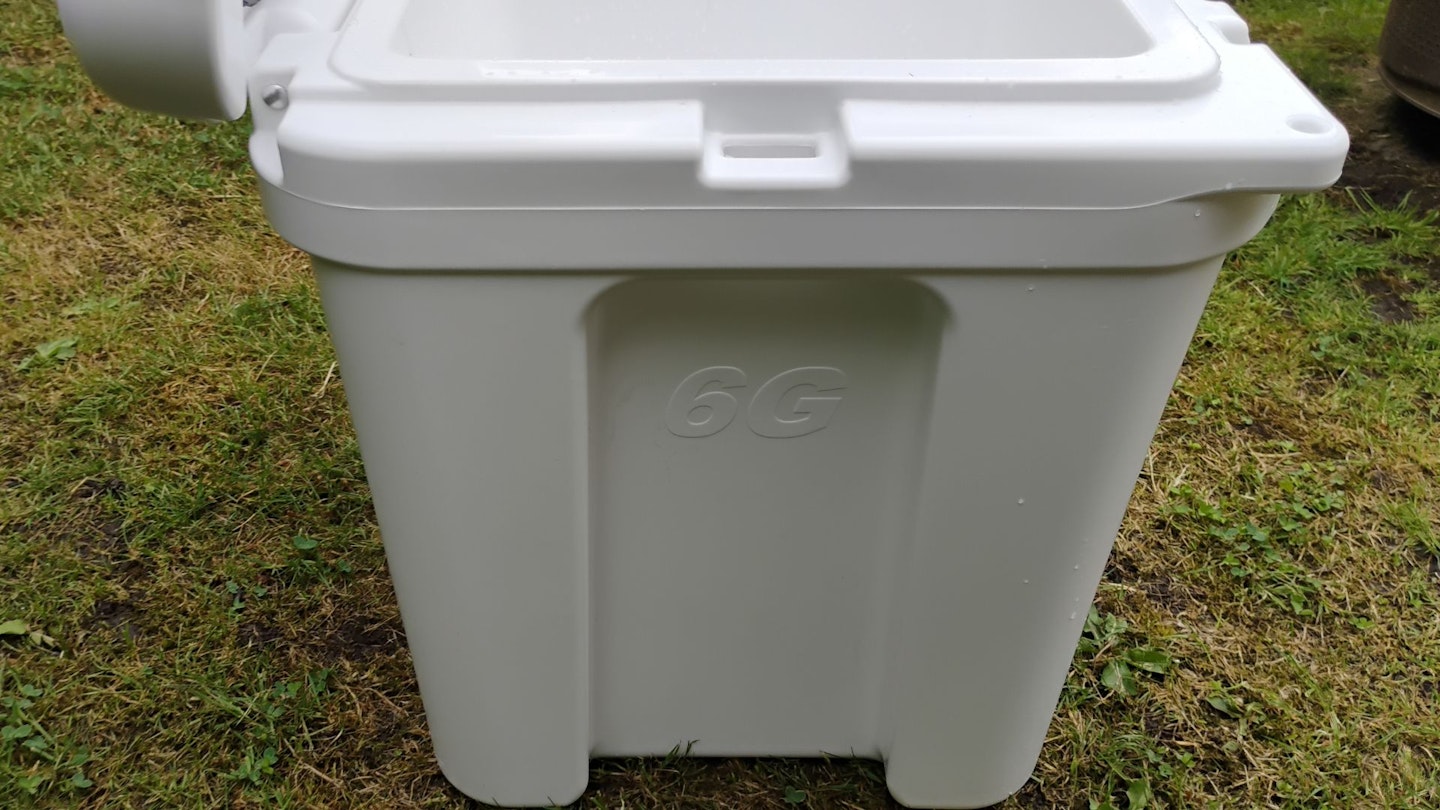Water flows, gushes, seeps and crashes. But if you have one of the best camping water containers, you can contain it quite well.
Thankfully, humans have developed clever ways to store water that aren’t just two hands cupped together. Now, you can get all sorts of water carriers, each of them begging to be added to your camping kit list.
You might say, what’s the point? Of course, you could just use a large water bottle, like one of those 5L ones you can buy from Tesco. Or multiple smaller hiking bottles.
But a carrier that’s specifically designed for camping is more practical. With multiple smaller bottles, you’ll be constantly going back and forth from source to camp.
And a large bottle isn’t likely to be durable, so it’s less sustainable. It’s probably tricky to carry, too, and will take up a lot of space.
Where to start, though? From collapsible containers and lightweight hydration bladders to rigid jerry cans, or even water tanks, there’s so many to choose from. Well, you’re in the right place.
What are the best water containers for camping?
Best in test: Ortlieb Water Bag
Best for car camping: Alpkit Kamel Water Carrier
Best budget buy: Quechua Camping Jerry Can
How we tested
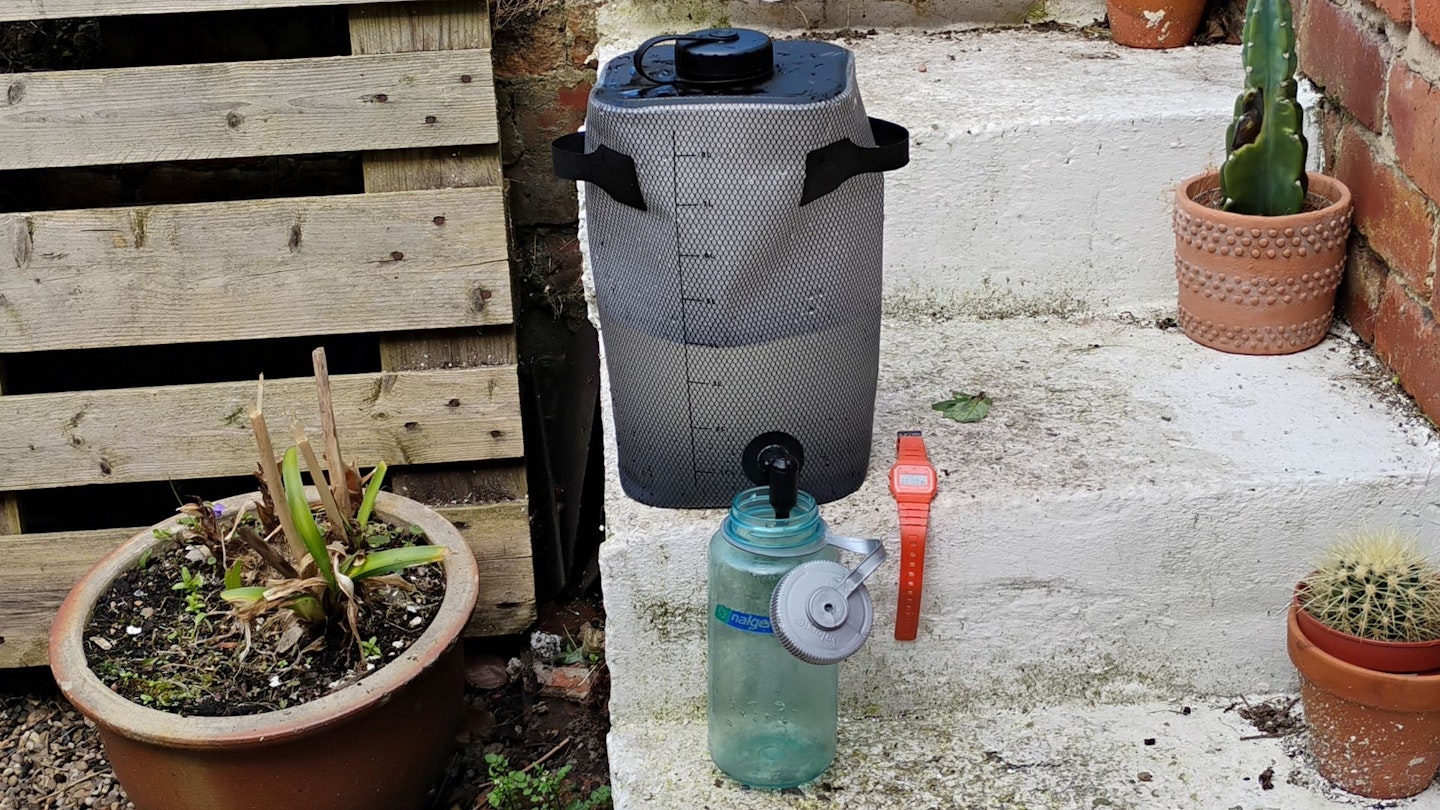
We selected these camping water carriers for their variety. We wanted to ensure that there's something for both casual campers and wild expeditions.
The containers here were tested from March-April 2025, by LFTO gear tester Evie Nichols. Using waste water where possible, she evaluated these containers against six criteria. She explains the testing process below:
Flow rate: I timed how long it took for each container to fill my 1L Nalgene bottle. While it would be possible to open the lid of each and simply pour, this test focussed on the flow rate of the spigot (a valve you twist or press to let water out).
Weight and packed size: This was tested using a tape measure and kitchen scales. The packed size refers to the smallest size I could achieve while the container was empty. It would be unfair to compare the weight of a 6L container against a 10L one, so I calculated their weight per litre.
Ease of use: I broke this down into three sub-criteria: ease of cleaning, pouring and filling up. While these may be easier with an extra pair of hands, this score is for one-person use.
Some containers are built for ease of use when backpacking, while others are geared towards campsites. To account for this, this rating is based on the most realistic scenario for each container.
Residual taste. I washed each thoroughly, then drank from them and ranked them from unpleasant to neutral.
Portability. This was determined by comparing the ease at which the containers are carried when full.
Durability: Where possible, I compared the denier rating of the fabric (a unit of measurement that describes the density of fibers). If this wasn't available, I researched the type of plastic and observed the carriers' features.
Curious as to how we get products in for review? Read how we test gear for more more info.
Best camping water carriers for 2025
The Ortlieb Water Bag is sensibly designed. It’s easy to use, robust and lightweight: perfect for multi-day adventures.
The Water Bag has a customisable valve system, with three pouring speeds. Even at the slowest speed, the flow rate is approximately 35secs/litre, which is one of the fastest in this group.
It’s very lightweight and compact. Thanks to two adjustable straps, with buckles for attaching to your backpack, it outperforms the other carriers in this test for ease of use.
As with all Ortlieb products I've tested, the fabric seems very durable. And even if you managed to snag it on a bramble, the German brand’s repair service and five-year warranty ensures the longevity of this bag.
On top of all of this, the Water Bag is highly versatile. You can use air or water to make a comfy pillow out of it. There’s also a shower valve and drinking tube you can buy as an add-on.
To sum up, the Ortlieb Water Bag ticks all boxes and then some. It’s robust and easy to use, with a clever valve system, but at the same time ultralight. At £27 RRP for the 4L version, it’s excellent value for money.
Pros
- Attaches to your backpack
- Highly robust
- Ultralight and compact
- Customisable pouring
- Versatile
Cons
- Potentially difficult to pour from unsupported
| RRP: | £27 (4L) |
| Capacity range: | 2, 4, 10L |
| Packed size: | 10x10cm |
| Weight: | 130g / 4.6oz |
Alpkit Camel
The Alpkit Kamel is another well-designed carrier, which we find suits casual camping very well, especially if you’ve got a table.
Like the Camelbak Fusion, the Alpkit Kamel is made mainly from TPU, which is known for its durability. The fabric has a rating of 840D, which is pretty heavy duty. The materials will keep your water reasonably cool, too.
Pleasingly, the Alpkit Kamel packs down to a very small size, but if you fill it with at least one litre of water, it’ll stand up on its own. This makes pouring easy if you’ve got a table.
It has a top-performing flow rate of approx. 29secs/litre, though the spigot dribbles a little. After one wash there’s some residual taste, but it’s nothing too unpleasant, especially since the materials are BPA and PVC free.
While it'd be ideal for camping with a car, I probably wouldn’t take it on backpacking trips. The spigot releases water when knocked, so it would be difficult to transport in a backpack.
Overall, the Alpkit Kamel shares many of the features of much more expensive carriers: it has an excellent flow rate, competitive pack size and durability – all for only £22.99.
Pros
- Highly durable
- Compact
- Easy to carry over short distances
- Excellent flow rate
Cons
- Needs a table/car boot for easy pouring
| RRP: | £22.99 / $34.99 |
| Weight: | 219g / 7.6oz |
| Packed size: | 10x30x5cm |
| Capacity: | 8L |
I'm impressed with the Quechua Jerry Can. At just £10.99, it outperforms similarly-priced alternatives. I'd say it performs almost as well as much more expensive carriers.
It’s very easy to clean, due to the large opening. This means it’s possible to remove the residual plastic taste. With enough water inside, it’ll support itself on a table, or there’s a strap for hanging, which is also helpful for carrying it. The flow rate is good, too (30secs/litre).
The main downside is that there’s very little to hold onto while filling, which becomes more and more of an issue as it fills up. You need both hands really, so if the campsite has a press-tap, this could be a challenge.
This container is best suited for use at the campsite, rather than on a wild camp. It’d be difficult to fill in a river or stream, or to transport in your backpack while full.
Pros
- Easy to clean
- Very little residual taste
- Simple to pour from
- Easy to carry
- Excellent flow rate
Cons
- Can be difficult to fill
| RRP: | £10.99 |
| Weight: | 206g/7.2oz |
| Packed size: | 25cm circumference x 33cm length |
| Capacity: | 10L |
The Sea to Summit Watercell X is ideal for self-supported multi-day adventures or overnight van trips.
The flow rate is excellent: roughly 33secs/litre. You can adjust the rate by removing the cap.
It’s pretty tough, too. The Watercell is made from 400D nylon fabric, with a TPU film, with a durable strap and buckles. It should be noted, though, that it has a strong residual taste, which we found difficult to remove. But it should be safe to drink from, as it’s BPA and PVC free.
The Watercell performs well for ease of use. The cap has an intuitive twist-lock mechanism. The opening is wide enough to make filling up easy, too.
Not to mention it’s highly portable. There’s an adjustable strap, which you can use alternately for pouring or carrying. It’ll dig into your shoulder if you carry it too far on its own, but can be carried inside your backpack.
This is one of the lightest containers in this test, so it'd be well-suited to backpacking. It packs down small, too.
At £55 RRP for the 10L version, it’s pricier than its most-similar rival, the Ortlieb Water Bag (above), but some might prefer the twist-lock valve.
Pros
- Very good flow rate
- Durable
- Very easy to use
- Highly portable
- Lightweight
- Trustworthy twist-lock valve
Cons
- Strong residual taste at first
- Won't easily attach to the outside of your backpack
| RRP: | £55/$64.95 (10L) |
| Weight: | 225g/7.9oz (10L) |
| Packed size: | 25cm circumference x 28cm length |
| Capacity range: | 4, 6, 10, 20L |
The CamelBak Fusion 10L is incredibly durable, portable and easy to use: ideal for use at base camp to support big groups.
It has a spigot with a high flow rate (approx. 36secs/litre), which is one of the fastest in this test. Though unlike other carriers, there’s no cap on the spigot, so it’s difficult to protect it from dirt.
The CamelBak Fusion scores highly for portability. There’s a thick, adjustable shoulder strap, as well as a handle at the top. It’s easy to pour from if you can hang it up.
This carrier is unique for its zip at the top, which is surprisingly watertight. It also enables easy cleaning, which means there’s very little residual taste. You really need two hands to keep it wide open, so it’s trickier to fill up from a stream.
It’s mainly made from TPU (thermoplastic polyurethane), which has a high abrasion resistance and shear strength. CamelBak states that it’s BPA/BPS/BPF free. Maybe because it's so durable, it's heavier per litre than most other options in this test.
This is the only container I tested that you can freeze to use as an icepack, which I found works well. It’s also compatible with a LifeStraw filter kit. So it gets bonus points for versatility. There’s a 6L and 3L version, too.
Pros
- Very durable
- Highly portable
- Good flow rate
- Easy to clean
- Versatile
Cons
- No cap to protect the spigot from dirt
- Heavier than similar alternatives
- Tricky to fill up from a river/stream
| RRP: | £95 / $126.37 |
| Weight: | 415g / 14.6oz |
| Packed size: | 30cm circumference x 31cm length |
| Capacity: | 3L, 6L, 10L |
The HydraPak Seeker is a good option for multi-day wilderness trips.
It’s very compact: all of the components fit, quite snugly, into the provided pack. For a 6L pack, it’s heavy compared to the other options in the list, but this must be because of the filter.
There’s quite a few different parts to this carrier, which we find intuitive to connect. You can remove the filter if needed and drink straight from the tap, which is handy.
There are some lash points which you could attach to your backpack. There's no strap to hold while pouring, which makes it quite tricky. For the 6L this is less of an issue, as it’s never super heavy, but I’d be wary of this for the 10L version.
The Seeker is clearly made of durable stuff (TPU coated nylon fabric), and is BPA and PVC free. Like the CamelBak Fusion, you can freeze this container.
The flow rate is much slower than the others in this test (around 90secs/litre), but this isn't surprising given it's filtered. There's a positive here though. Because of the filter, there isn’t much residual taste.
Pros
- Compact
- Intuitive to use
- Durable
- Very little residual taste
Cons
- Tricky to pour from
- Slow flow rate
| RRP: | £80 / $80 (6L + filter) |
| Weight: | 281g / 7.7oz |
| Packed size: | 24cm circumference x 22cm length |
| Capacity range: | 2, 3, 4, 6, 10L |
The Vango Expandable Water Carrier is basically a big plastic jug with a tap at the top. As one of the cheapest options in this test, it's best to compare with the Highlander options (below).
Unlike the Highlander carriers, it’s easy to pour from. You can unscrew the tap and simply pour the water out. This is handy, because the flow rate from the tap is slow (59secs/litre).
Thanks to a sturdy handle, it’s easy to carry and fill up. It packs down to almost flat, so it’s great for saving space. After a few washes, there’s little residual taste.
There’s a few question marks over long-term durability though, as the material doesn’t seem particularly abrasion-resistant. It also struggles to stand up on its own, so needs to be leant against something.
Overall, the Vango Expandable is a practical and budget-friendly option for camping with a car.
Pros
- Easy to pour from
- Pretty portable
- Easy to fill up
- Compact
- Little residual taste
Cons
- Might need support to stand up
- Not very abrasion resistant
| RRP: | £13 |
| Weight: | 298g / 10.5oz |
| Pack size: | 44x27x8cm |
| Capacity: | 12L |
 LFTO/Evie Nichols
LFTO/Evie Nichols
highlander-outdoor.com
The Highlander Accordion fits a deceptive amount of water. It packs down pretty small, but expands when filled. It’s relatively easy to carry and can be filled with ease.
This carrier is made from polyethylene, the same kind of plastic that bottles are made from. I found that there was very little residual taste.
As far as I can see, there’s no mention of it being BPA-free. While it seems durable in the short-term, I'm not sure whether it’d withstand several years of use.
The Highlander Accordion is very affordable, but this comes at a cost. The flow rate is slow (52s/litre). The handle is placed right next to the tap, which makes it difficult to pour from. Due to the accordion shape, it’s tricky to empty properly.
It’s huge though, so if you’re looking for a compact carrier for big groups – and don’t want to break the bank – then the Highlander Accordion is a good choice.
Pros
- Compact yet high volume
- Relatively easy to carry
- Straightforward to fill up
- Little residual taste
Cons
- Slow flow rate
- Question marks over long-term durability
- Tricky to pour from and empty
| RRP: | £11.49 |
| Weight: | 254g / 9oz |
| Packed size: | 31x26x3.5cm |
| Capacity range: | 10L, 15L |
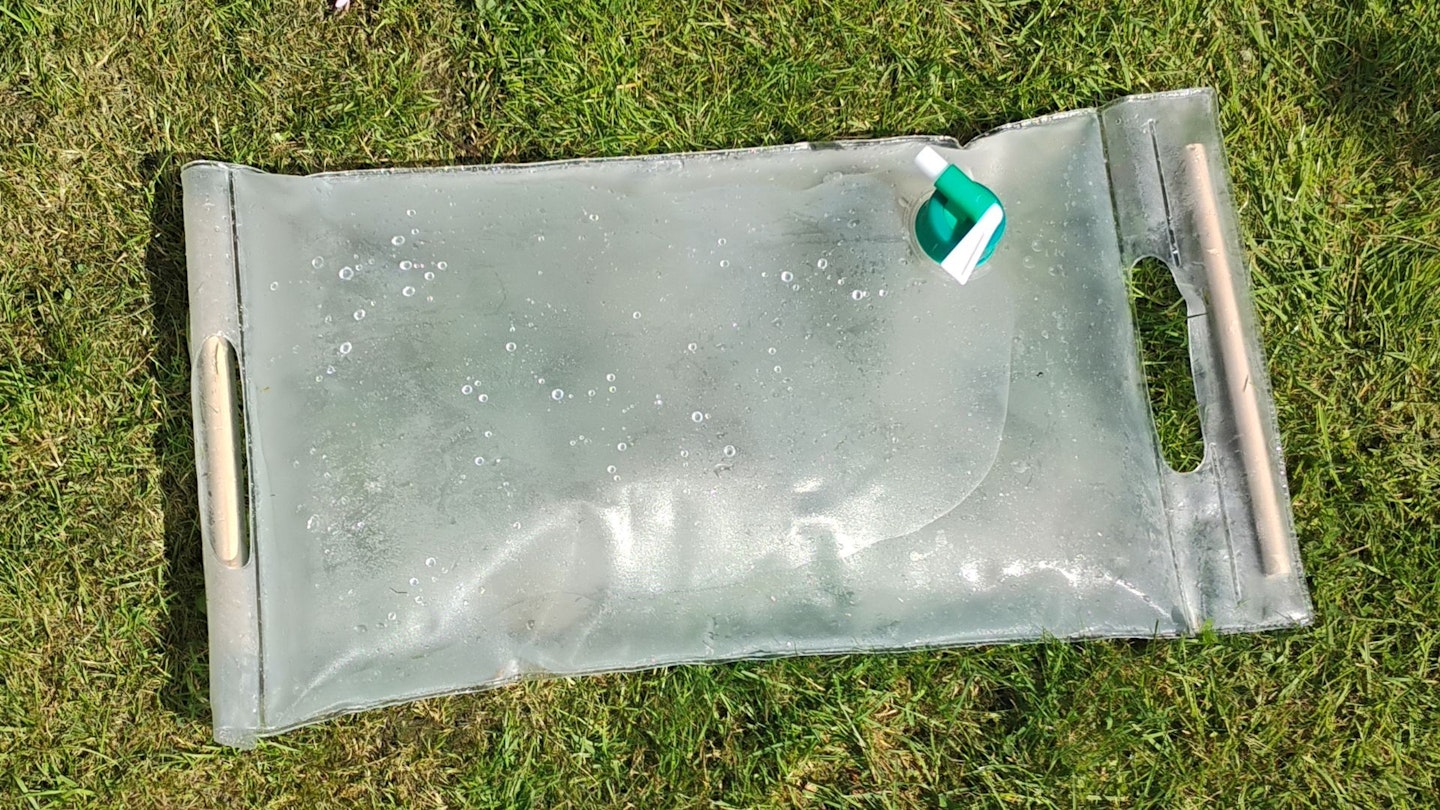 LFTO/Evie Nichols
LFTO/Evie Nicholshighlander-outdoor.com
The Highlander Roll Up water carrier is best compared with the Accordion.
At £6.99, it’s even cheaper, though it’ll carry less water. It’s more compact, though. With reinforced handles on each end, the Roll Up is easy to carry, and could easily be hung up.
Like the Accordion, it’s not the easiest to use. At 55secs/litre, the flow rate is slow. There’s not much to hold onto as it fills up. It’s a challenge to empty, as the lid is located in the middle of the bag, so you have to contort it to get the water out.
You’ll need to wash it pretty thoroughly to get rid of the residual taste, as we found it’s pretty strong. Highlander doesn't state whether it’s BPA-free, either.
You can’t deny that the Highlander Roll Up is cheap, though, and I'd say it's more practical than using two 5L water bottles from the supermarket.
Pros
- Pretty compact
- Easy to carry
- Can be hung up
Cons
- Slow flow rate
- Difficult to fill up and empty
| RRP: | £6.99 |
| Weight: | 225g / 7.9oz |
| Packed size: | 20cm circumference x 32cm length |
| Capacity: | 10L |
YETI claims that the Silo is as a “powerhouse” of a cooler, which sounds about right. Made from rotomolded plastic, it's extremely durable. The hinges are encased and held by two pins; the spigot is protected by a steel handle; the carrying handles are in-built; the lid latches are made from heavy-duty rubber.
The Silo outperforms the other carriers in this test for flow rate. According to my tests, it pours 1L in 21 seconds. The spigot couldn't be more straightforward, like pressing a button. You can take it apart for cleaning, though this is fiddly. The interior is easy to clean, which means there’s very little residual taste.
Unsurprisingly, it’s heavy – apparently roughly 7.5kg when empty. With nothing inside, it’s easy to carry over a couple of hundred metres, thanks to a couple of handles. There aren’t any pack straps, so it’s tricky to carry when full. It's easy to transport inside your vehicle though, as the Silo has four grippy feet, as well as tie-down slots, which prevent it from sliding.
It’s very well-insulated, with super-thick walls. In my test, it took roughly four days to return to tap temperature after being filled with approx. 20L of ice and water (at a 2:1 ratio). This seems to be in line with other reviewers' findings.
The only real downside is the price-tag. It’s easy to find containers of a similar volume for cheaper, but you probably won’t be able to keep your water cool as effectively, and they're unlikely to be as durable.
The bottom-line is: this is an exceedingly trustworthy cooler for expeditions, but for family camping – especially in the UK – it's probably a bit overkill.
Pros
- Ultra-rugged design
- Outstanding flow rate
- Very little residual taste
- Straightforward to use
- Keeps water cool for several days
Cons
- Way more expensive than most alternatives
- Difficult to carry when full
| RRP: | £300/$300 |
| Weight: | 7.5kg/16lb 8.5oz (empty) |
| Dimensions: | 39.6cm x 45.4cm |
| Capacity: | 22.7L/6 gallons |
What to look for in a camping water carrier?
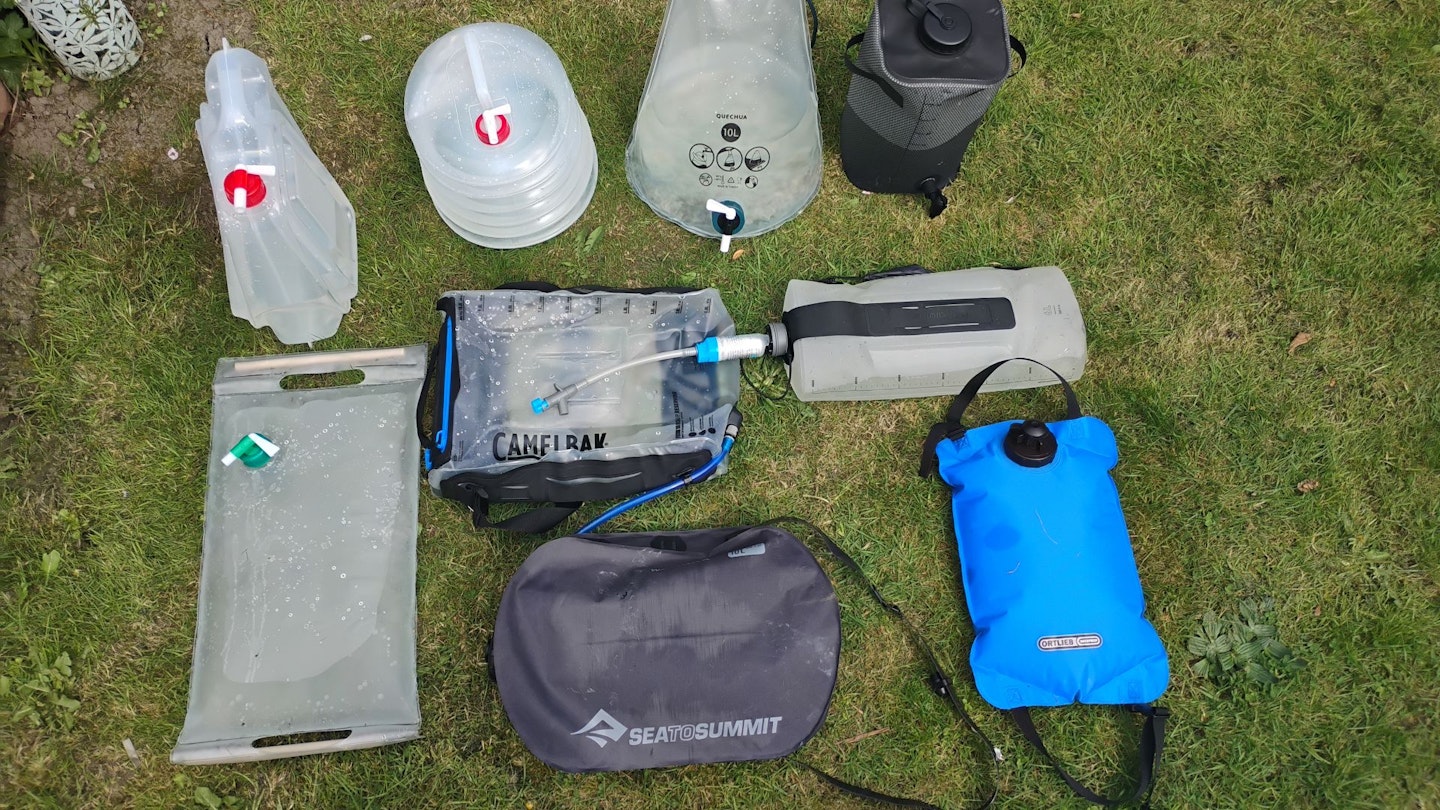
Portability
After filling up your container, it’s important to be able to carry it easily back to camp. Check out the carrying method: is there a strap or a handle? How adjustable is the strap? Is the handle located at the top or on the side?
If your container has a large capacity, say more than 6L, then it’s easiest to carry with a strap over your shoulder. Or, even better, you might be able to attach it to the outside of your backpack, if there’s more than one strap.
Material
All of the containers we’ve come across while researching this review are made of some kind of plastic. The type of plastic water containers are made from varies, though.
The cheapest containers are made of polyethylene, a tough clear plastic. These kinds of containers feel similar to traditional water bottles and will probably degrade over time quite quickly. There’s a chance they might lose their shape over time as well.
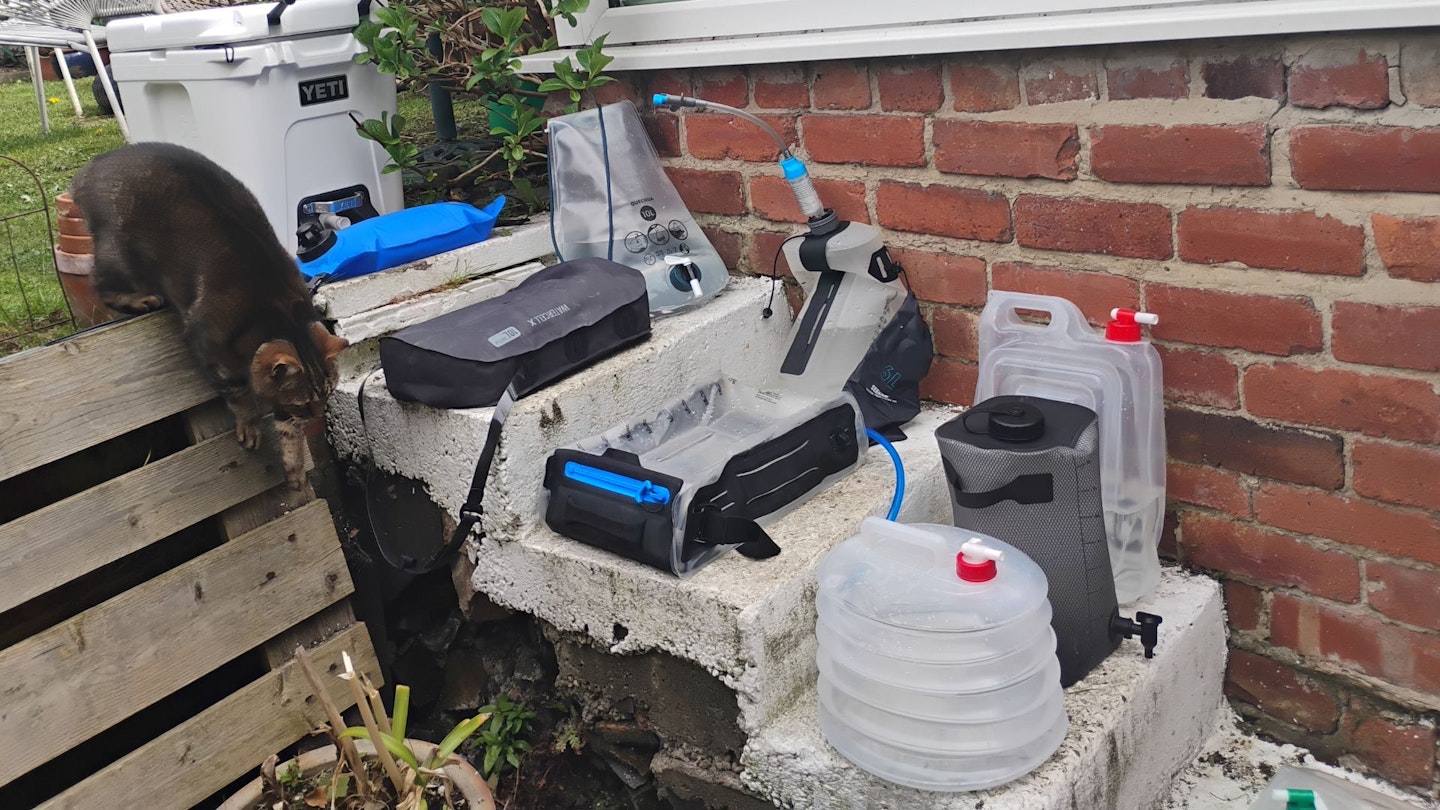
Others, including the Alpkit Kamel and Camelbak Fusion, are made from TPU (thermoplastic polyurethane). This is a flexible plastic, which is easy to pack down to a smaller size. It’s also highly durable and abrasion-resistant.
Most containers are BPA-free, but it’s worth checking in the product description whether this is the case (more on this below).
Ease of use
Pouring: Some containers are easier to pour from than others. Self-standing containers with a tap at the bottom, like the Alpkit Kamel and Quechua Jerry Can, really need a table to be used effectively. Rather than awkwardly holding the container and attempting to pour, you can just place your cup underneath it and turn the tap on.
Others need to be hung from a tree or hook or held by another person for easy pouring. This kind of carrier has a strap at the top and a valve at the other end. Without anything to hang from, it can be pretty fiddly.
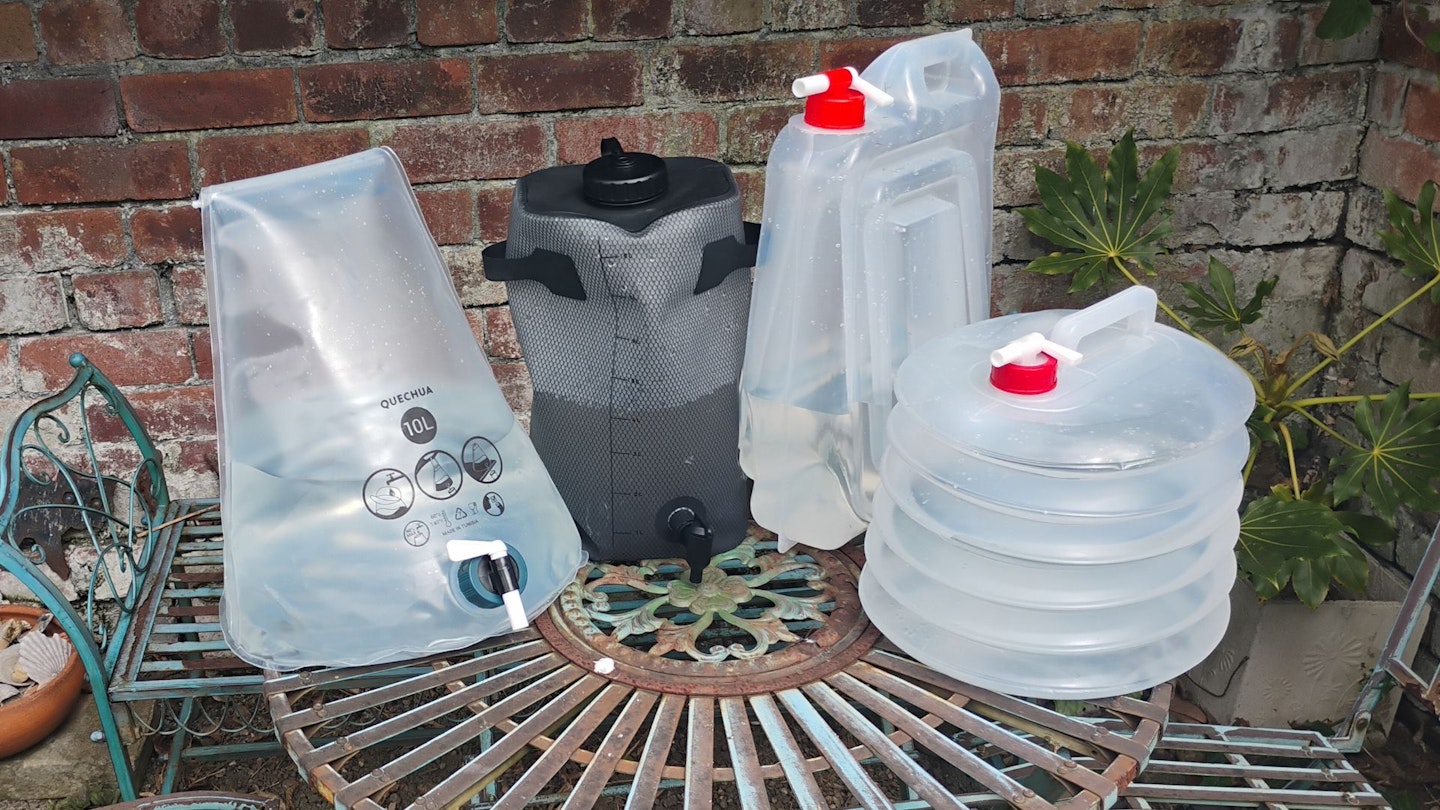
All of the containers in this test have an unscrewable lid, so if you’re getting impatient with the tap, you can let the water out through the lid. Bear in mind, though, that rigid containers tend to be easier to pour from, as you can easily control the flow of water.
It’s worth checking where the handle is in relation to the lid, as if it’s right next to it, it’s more difficult to pour from.
Cleaning: For most containers in this test, cleaning was a struggle. The containers which are the easiest to clean have a large opening (Quechua Jerry Can, Camelbak Fusion), so you can reach inside with a sponge. This also helps to reduce residual plastic taste. For some tips on cleaning your container, check out the FAQs below.
Filling up: As water fills the carrier, sometimes it’s hard to keep a grip on it. The containers that are easiest to fill have a sturdy handle to hold onto, either at the top or on either side. Make sure the opening is at the top, rather than the middle.
If you’re wild camping, it’s best to use a carrier with a wide, bottle-like opening – like the Ortlieb Water Bag and Sea to Summit Watercell. This will help you to easily fill up from natural water sources.
Weight and pack size

Most camping water containers are designed to pack down small, so they'll fit into your boot or backpack. If space is at a premium, it's best to choose a container that collapses into itself or folds up easily when empty.
Weight and pack size are a concern for backpacking. The most suitable containers are made from flexible plastic, which you can roll. For packability, it's best to opt for a carrier with a twist valve, like the Sea to Summit Water Cell. Avoid valves that work through a lever, like the one pictured on the Highlander Accordion (above).
Of course, both weight and pack size depend on carrying capacity. Ultralight containers, like the Ortlieb Water Bag, start at around 80g for a 2L container.
What’s the best way to store water for camping?
It’s best to use a purpose-built camping water container (see above for our favourite picks). You could use several plastic 1-2L water bottles, or one 5L bottle from a supermarket, but these options aren’t likely to be durable and will use up a lot of space.
Plus, a purpose-built container is easier to re-use, so it’s more sustainable. Generally, these kinds of containers are easier to carry back-and-forth from your tent to the tap.
What type of container is best for storing drinking water?
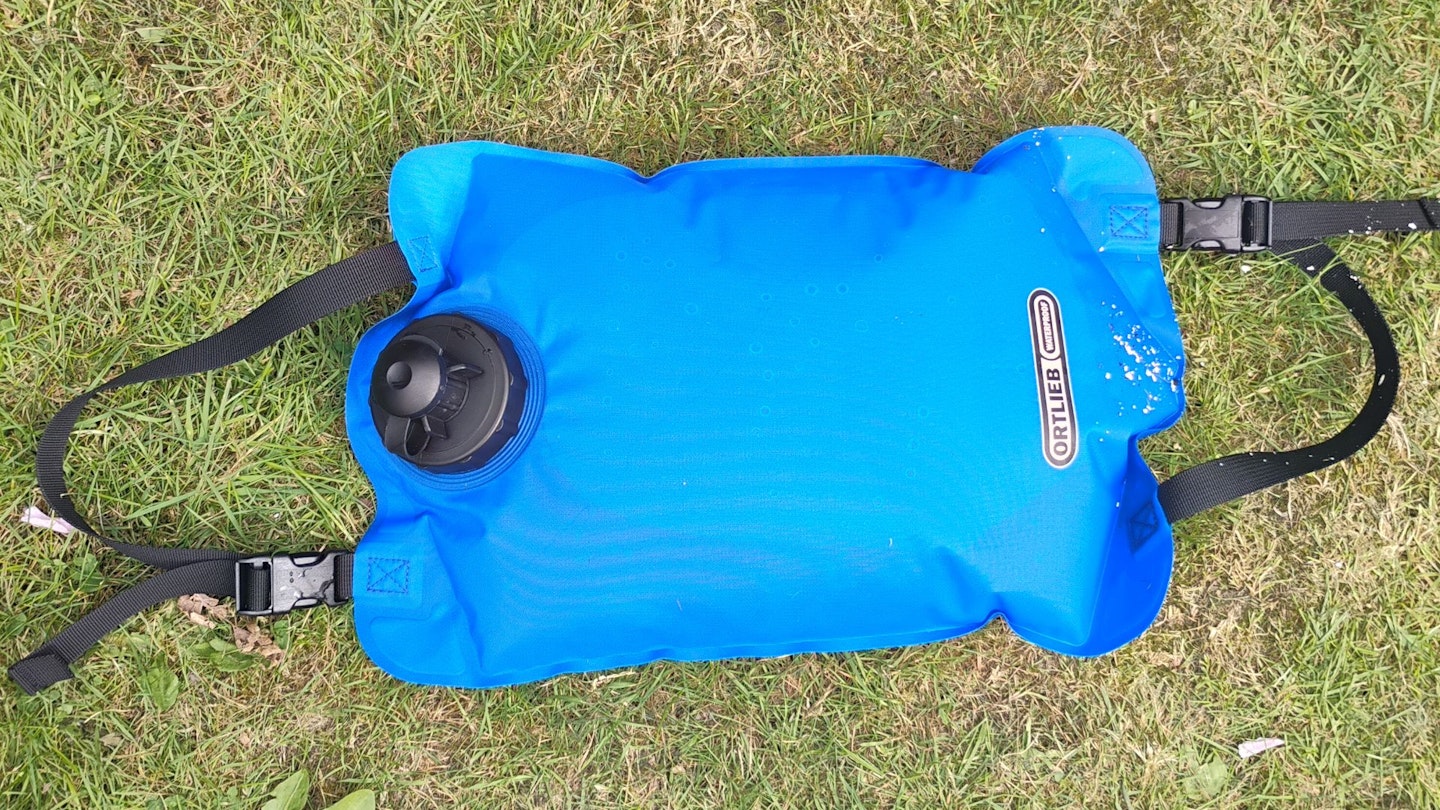
There are four main types of container: jerry cans (rigid jug-like containers), collapsible containers, water bags and water bottles.
The best container for you will depend on your needs. If you need a sturdy and durable option, say for camping with a car, opt for a jerry can. A collapsible container would be best if you need to save space.
A water bag is best for hiking, as you can drink on-the-go or transport water in your backpack. One with a large capacity (4L+) is particularly useful for wild camping away from water sources.
On long day-hikes, it’s best to take a reusable water bottle with you. They’re more sturdy and sustainable than one-time plastic bottles. For inspiration, see our review of the best hiking water bottles.
What is the healthiest container to store water in for camping?
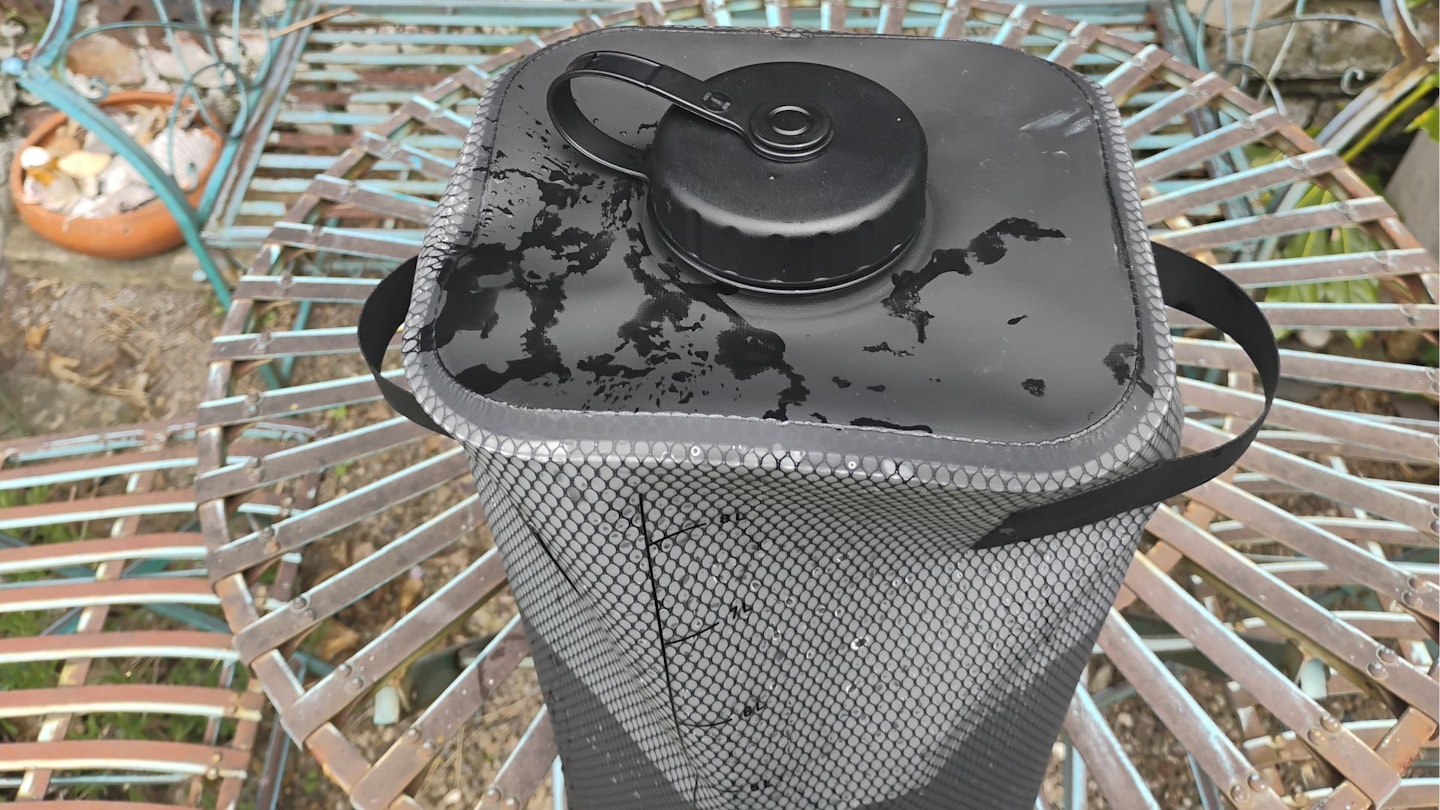
Mid and top-range water containers, like the Alpkit Kamel, are made from BPA-free plastic. This means that they don’t contain bisphenol A, a chemical compound that some studies suggest poses a risk to health.
There’s still significant gaps in knowledge here, so we don’t know for sure, but it’s probably best to assume that the healthiest options are made from BPA-free plastic.
How much water do I need for 24 hours camping?
It’s generally agreed that you should drink at least 2L during the day, but this varies wildly depending on your level of activity and how warm it is.
At night, you’ll need at least 2-3L for making dinner and drinking, and don’t forget the morning, too, as you'll no doubt be wanting to fill up those camping mugs with coffee or tea.
If you’re hiking up Ben Nevis on a hot summer day, with a heavy backpack, you’ll get dehydrated much quicker. So you’ll need more water to replace the fluid lost through sweat.
In this case, I’d make sure I'm well hydrated beforehand and take at least 3L with me. If there’s no option to fill up en route, I’d also take plenty for overnight. This is subjective though, and you might find you need much more (or less).
How do I clean my water container?
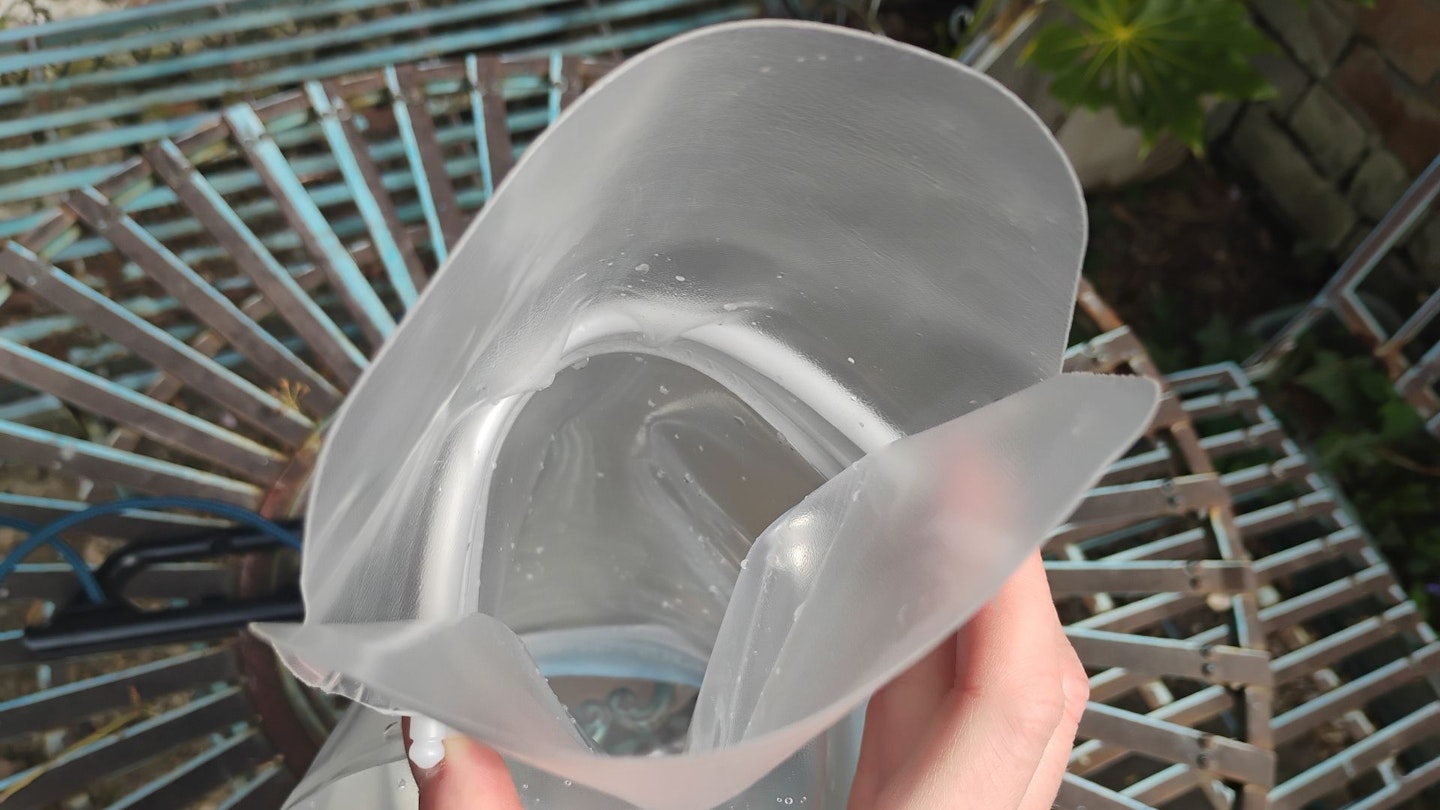
To clean your water container, start by adding warm water and a bit of washing-up liquid. Swirl the mixture around the inside, then rinse. For hard-to-reach areas, an old toothbrush works well. It’s also important to clean the valve thoroughly, as build up can collect there and affect water quality.
To keep your container clean over time, make sure it stays well-ventilated and avoid leaving water sitting in it longer than necessary. Try to use clean water to begin with, as this helps prevent contamination.
About the author

Digital writer Evie has set up her trusty Wild Country tent on hiking and cycling trips all over Europe, and beyond.
She's a big fan of finding the perfect camping spot, which sometimes leads her away from water sources. Luckily, she's always got a good water carrier with her, so fills up at the nearest stream and continues on. What exactly she's searching for, we might never know.






















